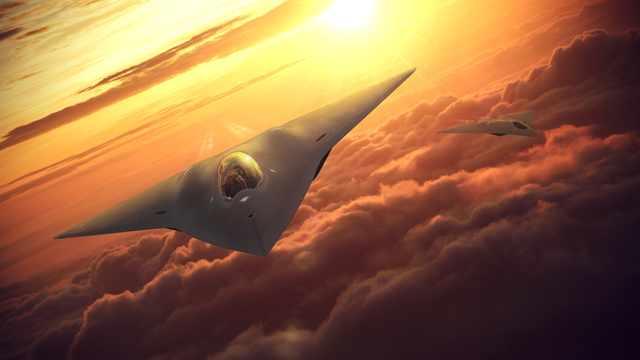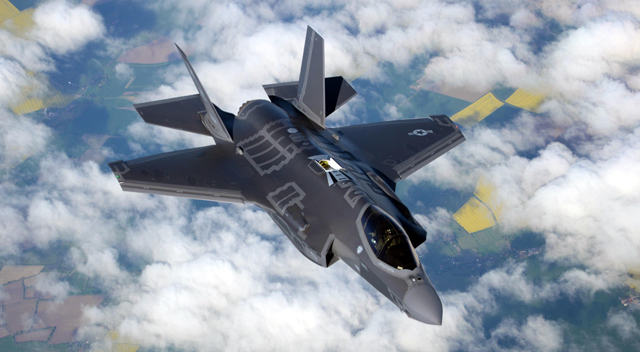As the US Air Force approaches production on its Northrop Grumman B-21 bomber and eyes full operational capability for its Lockheed Martin F-35A, the service is examining the future of air superiority with its next-generation air dominance (NGAD) concept.
Last April, the USAF wrapped up its 2030 air superiority study, which assessed its limitations against future airpower threats. While the study did not name particular adversaries, the document included a picture of China’s AVIC Chengdu J-20 stealth fighter. More broadly, the USAF has warned against the growing threats in an increasingly complex anti-access/area denial environment.

This Lockheed Martin concept is a spark for imagination rather than a hard clue as to the appearance of a future fighter
Lockheed Martin
The study, led by Brig Gen Alexus “Grynch” Grynkewich, also criticised traditional platform-based acquisition practices, instead favouring a strategy to develop prototypes that can be transitioned into development as they mature.
Vote of confidence
Even with the unorthodox acquisition practices of US President Donald Trump, who has ruffled the feathers of both Boeing and Lockheed executives with his critiques of the Air Force One recapitalisation and the F-35 programme, the administration appears to have invested its confidence and dollars in NGAD. In the president’s proposed fiscal year 2018 defence budget, the programme picked up some research and development steam. The USAF proposed a significant increase to NGAD, from $21 million in FY2017 to $294 million in FY2018.
With the 2030 study completed, the air force is now in the middle of the NGAD analysis of alternatives (AOA). The additional research funding will allow the service to analyse future threats, informed by the 2030 study.
The gaps identified in the study have already allowed the USAF to shift its resources towards areas that will enable future air superiority, says Col Tom Coglitore, concept development lead for the Air Superiority 2030 effort. That is evident in the FY2018 budget and will allow the air force to plan 30 years out, he says.
Both the USAF and industry have used the phrases NGAD and PCA – penetrating counter-air – almost interchangeably to describe the air dominance concept, though service officials only recently clarified the semantics. Specifically, the term “penetrating” in the counter-air description appears antithetical to the air force’s characterisation of the aircraft as a “standoff” platform.
“The nuance is, as you’re standing off with your vehicle, you’re still seeing deep with your sensors,” Dave Bujold, director of fixed-wing programmes for Boeing Phantom Works tells FlightGlobal. “I think that’s what they’re really talking about when they talk about a standoff capability on NGAD.”
NGAD has always referred to the programme element in the budget as well as the AOA, which will determine attributes for PCA, Coglitore says. There are several capabilities within the NGAD concept, and PCA is one of them, he says. PCA will provide a full spectrum of operations, from high- to low-end, so the concept could pursue both standoff and a stand-in capability, he adds.
“When Grynch speaks, he doesn’t talk about specific platforms,” Coglitore says. “We usually talk about a family of capabilities which came out of the ECCT [air superiority enterprise capability collaboration] team, that he led, so there are several different capabilities. PCA is one of those.”
Although the air force’s quibble over names looks like another example of Washington’s acronym alphabet soup, the slippery characterisation of PCA or NGAD seems to encapsulate where the programme is heading. Unlike past USAF fighter jet acquisitions, NGAD may not shape up to be one fighter-type platform. Over the past year, Grynkewich eschewed both the terms “fighter” and “sixth-generation” platform. That may also hint at an effort to distinguish PCA from the maligned F-35 programme.

Like its rival Lockheed Martin, Boeing is exploring tailless concepts for enhanced survivability
Boeing
Grynkewich told reporters that PCA’s requirements as an air superiority platform, rather than an air-to-ground aircraft, would make it more difficult to find commonality across the services.
“In an air superiority mission, it’s fundamentally a different set of problems,” he says. “So for the navy it’s about fleet defence, some limited power projection. For the air force, it’s how do I go wherever I need to go in the world, and I need air superiority to do that.”
While he admits the future platform may end up with an “F” designation in the end, he says PCA’s range, persistence and lethality will not look like today’s fighters, which still embrace 20th-century warfare tactics.
USAF officials still have not identified where PCA fits in – such as whether it could look more like a fighter or a bomber – although longer range and survivability will remain key attributes. Both Boeing and Lockheed NGAD concept art feature tailless supersonic aircraft, but the companies say that is just one option.
“Whether or not that future fighter would have those features is to be determined,” Bob Ruszkowski, director of air dominance and strike systems at Lockheed’s Skunk Works, tells FlightGlobal. “Although I think you could safely say that aircraft that have enhanced survivable characteristics, many of them don’t have tails. We’re in the midst of exploring these different technologies – the illustration is more or less to spark the imagination.”
PCA’s range will outstrip an F-22’s, but Grynkewich is not sure whether its range would be greater than that of a bomber. He also referred to his ideal platform as a “sensor shooter”, which would allow salvos not only from PCA, but would also enable any standoff weapon in the air force’s inventory.
“When we think about air superiority, we don’t think about fighter jet combat anymore,” Grynkewich told an audience on Capitol Hill in July. “We need to think about how it’s a network of capabilities that come together in order to achieve that air superiority. If technology was at the point where you could just make one system that could do all of that in some package, like the Death Star or something, maybe you’d want to do that, maybe you wouldn’t.”
Fresh approach
Depending on the AOA’s outcome in a year’s time, PCA could step back from previous fighters’ emphasis on stealth. Rather than focus on stealth alone, as the air force has with the F-22 and F-35, PCA could gravitate toward a mix of capabilities, such as speed and electronic warfare, which complement each other.
Coglitore’s comments echoed the ECCT study’s critical look at recent USAF procurements and seem to point to an NGAD concept that will break away from the traditional development cycle that has characterised the service’s recent fighter and bomber acquisitions. Coglitore has also said NGAD could be more than one platform. The ECCT flightplan included Air Force Research Laboratory unmanned air vehicle concepts, such as the Low Cost Attritable Strike Demonstration and the Pentagon Strategic Capabilities Office’s Arsenal Plane concept, which could take an aircraft like the Boeing B-52 out of inventory to create a larger airborne magazine.

One possibility for the service's future capability could be an enhanced version of the F-35A
USAF
“If you look at the capability we’re looking to pursue, it’s more than just a fighter. I look at it more as a weapons or sensor truck,” he says. “Those folks who say it’s a fighter are looking at it old school versus how we have looked at it for several years now.”
Ruszkowski says the jury is out on PCA’s configuration until the AOA is revealed. But he still sees fighters as part of the USAF’s future and envisages them working in concert with unmanned platforms. However, he does not believe the air force is ready to employ a Loyal Wingman – a concept that aims to multiply a manned fighter’s capabilities by teaming it with an autonomous jet – as part of PCA.
Development need
“They have a long way to go, not only on the military side but on the civilian side, to be able to train more freely with unmanned systems,” he says. “There’s a lot of work going on with unmanned regulations with the FAA. You have to be able to train with those systems, and to be able to train you have to more readily transit civil airspace.”
As the USAF examines which technologies could buy their way onto a platform by 2030, the service is also taking a critical look at some of the capabilities that have been “just around the corner” for decades. While the air force has long sought the unlimited magazine that direct energy could bring to an aircraft, Coglitore says the service wants to chase gaps in capabilities, not technologies. There is no requirement to field a laser on an aircraft for the NGAD concept, but the AOA will help determine how easily those technologies could be integrated onto a platform, he adds.
As part of the USAF’s effort to break away from tired acquisition practices, the service’s head of Air Combat Command hinted at a rapid acquisition plan for PCA earlier this year. That plan would allow the air force to purchase PCA aircraft in batches and add capabilities, such as directed energy, along the way.
“I want directed energy as soon as I can get it and as soon as it works. Not a moment before and not a moment after,” Grynkewich says. “When that moment happens, we need to have in place the ability to incrementally improve upon whatever platforms exist.”
As with all AOAs, the air force is weighing up whether to include legacy systems or even change concepts of operations for the next-generation air dominance concept. But the defence industry, which is also providing the air force feedback on the AOA, seems keener to capture another major defence acquisition programme than update existing systems.
“If you look at how they do AOA, they look at doing things as surprisingly simple as changing the doctrine to see if they can accomplish the mission, or doing better training,” Bujold says. “They’re [also] looking at a material option, and Boeing stands ready to support the decision to go after a new material option.”
For Lockheed, the AOA might bring out the possibility of enhancing existing F-35s. Although some have characterised PCA as an F-22 replacement, pointing to its emphasis on air superiority, Ruszkowski believes that is a narrow approach. Although he will not comment on PCA directly, he says the F-35 is not primarily an air-to-ground machine.
“F-35 is going to have a long service life and it will be modified over time: capabilities will be added to it,” he says. “There might be more in the future – whether the aircraft could be modified to fill other mission roles, I think that’s to be determined depending on how requirements unfold.”
Boeing is also leveraging its expertise from its work on the missions systems on both the F-22 and the F-15 for its PCA venture. In May, Boeing officials hinted that technology developed on the Advanced Eagle could make its way onto PCA. Boeing’s bid would not necessarily have the same “outer mould line”, but it would leverage the F-15’s updated mission computers and advanced radars, Bujold says.
Source: FlightGlobal.com



















